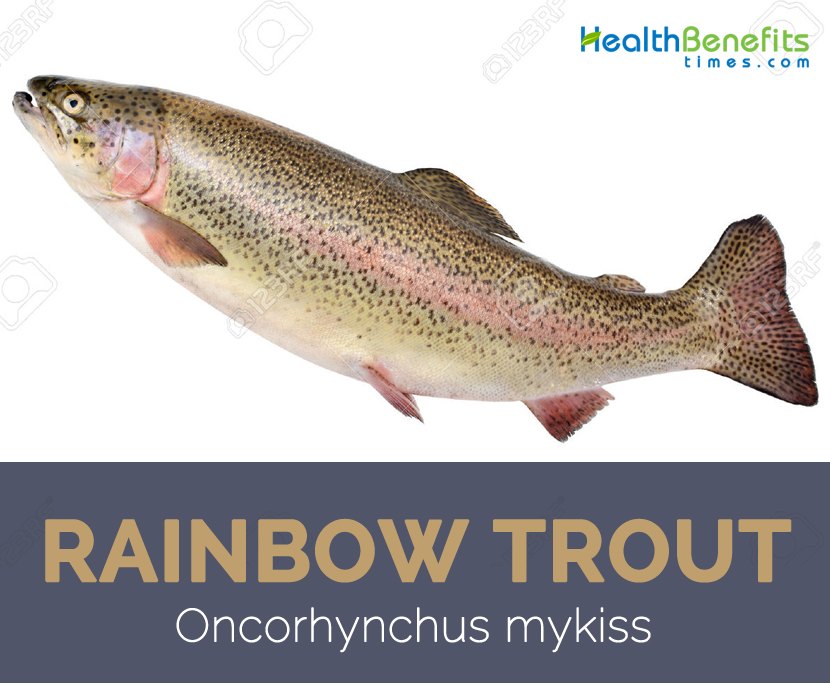| Rainbow trout Quick Facts |
| Name: |
Rainbow trout |
| Scientific Name: |
Oncorhynchus mykiss |
| Origin |
Rivers and lakes of North America, west of the Rocky Mountains |
| Colors |
Generally blue-green or yellow-green in color with a pink streak along their sides, white underbelly, and small black spots on their back and fins. |
| Shapes |
Large, torpedo shaped fish about 20 to 30 inches (51 to 76 centimeters) long |
| Flesh colors |
White, pink, orange or dark red in color. |
| Calories |
119 Kcal./cup |
| Major nutrients |
Vitamin B-12 (121.67%)
Vitamin D (90.00%)
Isoleucine (48.74%)
Lysine (48.56%)
Tryptophan (45.00%)
|
| Health benefits |
Excellent alternative for protein, High in omega-3 fatty acids, Rich in potassium, Good source of Phosphorus, Excellent source of the B-vitamin complex, Good source of the forgotten selenium, Low in contaminants |
Rainbow trout, which belongs to the Salmo family of fish, is closely related to salmon and Arctic char – two other fish rich in omega-3 fatty acids. It is native to cold-water tributaries of the Pacific Ocean in Asia and North America. Rainbow is the most widely known trout in the world and is highly sought after by anglers because of their strong fighting abilities. In Alaska, there are two commonly recognized forms of the rainbow trout and these sub-groupings or “forms” are based primarily on where they spend their time feeding and maturing. The most common rainbow trout in Alaska is the stream-resident form that lives its life entirely in freshwater with maybe short periods of time spent in estuarine or near-shore marine waters. The second form is commonly known as steelhead and these rainbow trout leave freshwater as juveniles and migrate long distances in the ocean where they grow to maturity before migrating back to their original home waters.
Appearance
The rainbow trout is a large, torpedo shaped fish that usually reaches a weight of 8 pounds and a length of 20 to 30 inches in the wild. It is speckled with black spots on its bluish-green back, with a silver belly and a pink stripe on the sides of its body. Though, the rainbow trout’s coloration often varies depending on age and habitat. In addition to their black speckles, young fish have 8 to 13 dark vertical spots on their sides, called parr marks, which fade as they grow older. Rainbow trout living in fresh water habitats are often lighter in color than their counterparts in saltier waters. Some rainbow trout spend part of their life in the ocean. They are called anadromous or steelhead trout. Their body is almost entirely silver.
History
Rainbow trout is native to North American rivers draining into the Pacific Ocean; trout are now farmed across the United States for food and for sport. North Carolina is the second largest producer of rainbow trout after Idaho. They are grown in earthen or concrete, rectangular raceways supplied with clean, flowing water. Without a good source of water, trout farming is impossible.
Nutritional Value
Apart from their mild, nutty taste, rainbow trout is a good source of nutrients, vitamins and minerals. Consuming 71 gram of rainbow trout offers 2.92 µg of Vitamin B-12, 13.5 µg of Vitamin D, 20 µg of Selenium, 16.9 g of Protein, 4.719 mg of Vitamin B3, 1.413 mg of Vitamin B5, 192 mg of Phosphorus, 0.274 mg of Vitamin B6, 5.24 g of Total Fat and 1.98 mg of Vitamin E. Moreover many Amino acids 0.198 g of Tryptophan, 0.775 g of Threonine, 0.815 g of Isoleucine, 1.438 g of Leucine, 1.624 g of Lysine, 0.524 g of Methionine and 0.19 g of Cystine are also found in 71 gram of rainbow trout.
Trout Species
Different types of Rainbow trout are mentioned below
1. Brook Trout (Salvelinus fontinalis)
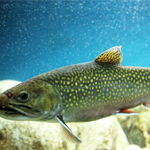 The brook trout or speckled trout is the only trout native to North Carolina. This member of the char family is found only in Coldwater streams of the mountains. Often a brilliantly colored fish, it is readily identifiable by the white leading edge, backed by black, on its lower fins.
The brook trout or speckled trout is the only trout native to North Carolina. This member of the char family is found only in Coldwater streams of the mountains. Often a brilliantly colored fish, it is readily identifiable by the white leading edge, backed by black, on its lower fins.
2. Steelhead Trout
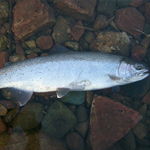 This anadramous (ocean-going) form of a rainbow trout is born in freshwater streams and rivers in the mountains along the West coast of the US, grows to adulthood in the Pacific Ocean, and returns to freshwater to spawn. Because of the time they spend in the ocean, they typically reach much larger sizes than their landlocked cousins, though they are less colorful.
This anadramous (ocean-going) form of a rainbow trout is born in freshwater streams and rivers in the mountains along the West coast of the US, grows to adulthood in the Pacific Ocean, and returns to freshwater to spawn. Because of the time they spend in the ocean, they typically reach much larger sizes than their landlocked cousins, though they are less colorful.
3. Brown Trout (Salmo trutta)
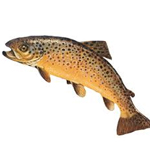 Brown trout, native to northern Europe, were introduced into this country from Germany and Scotland in the late 1800s. Brown trout can be well-known by their brownish-yellow color and the scattered black, red, and orange spots on their sides. The typical brown trout taken from North Carolina water is 12 inches or less in length, but fish greater than 18-inches long are occasionally taken. Brown trout are extremely wary and are the most difficult of the trout to catch.
Brown trout, native to northern Europe, were introduced into this country from Germany and Scotland in the late 1800s. Brown trout can be well-known by their brownish-yellow color and the scattered black, red, and orange spots on their sides. The typical brown trout taken from North Carolina water is 12 inches or less in length, but fish greater than 18-inches long are occasionally taken. Brown trout are extremely wary and are the most difficult of the trout to catch.
4. Cutthroat Trout (Oncorhynchus clarki)
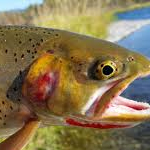 Cutthroat trout are indigenous to the Rocky Mountains. They get their name from the distinctive red coloration around their throat, and they were first described to the scientific community by the Lewis & Clark expedition.
Cutthroat trout are indigenous to the Rocky Mountains. They get their name from the distinctive red coloration around their throat, and they were first described to the scientific community by the Lewis & Clark expedition.
5. Golden Trout (Oncorhynchus mykiss aguabonita)
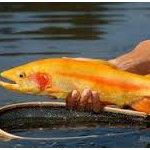 Golden trout are found in the upper elevations of the Sierra Nevada Mountains. They are a subspecies of Rainbow Trout.
Golden trout are found in the upper elevations of the Sierra Nevada Mountains. They are a subspecies of Rainbow Trout.
6. Palomino Rainbow Trout
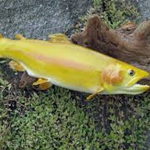 Golden rainbow trout and palomino rainbow trout are not sterile hybrids; they are simply color variations of rainbow trout (Oncorhynchus mykiss) and should not be confused with the golden trout (Oncorhynchus aguabonita) native to a few drainages in California. It took selective breeding for several generations to result in the development of true breeding golden rainbow trout. Typically, these fish are more of a brilliant golden color than the palomino rainbow trout, which has a color phase intermediate between the golden and normally pigmented rainbow trout.
Golden rainbow trout and palomino rainbow trout are not sterile hybrids; they are simply color variations of rainbow trout (Oncorhynchus mykiss) and should not be confused with the golden trout (Oncorhynchus aguabonita) native to a few drainages in California. It took selective breeding for several generations to result in the development of true breeding golden rainbow trout. Typically, these fish are more of a brilliant golden color than the palomino rainbow trout, which has a color phase intermediate between the golden and normally pigmented rainbow trout.
7. Bull Trout (Salvelinus confluentus)
 Bull trout are in the char family. They are usually found in the higher elevations of the Western US mountains, from Alaska to Nevada.
Bull trout are in the char family. They are usually found in the higher elevations of the Western US mountains, from Alaska to Nevada.
8. Lake Trout (Salvelinus namaycush)
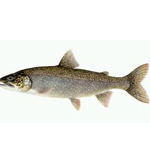 Lake trout, found primarily in lakes in the northern parts of North America, are members of the char family. They are typically found deep in lakes, and they are often caught by trolling.
Lake trout, found primarily in lakes in the northern parts of North America, are members of the char family. They are typically found deep in lakes, and they are often caught by trolling.
9. Dolly Varden (Salvelinus malma malma)
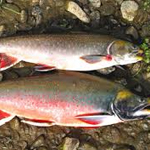 Dolly Varden, named for a character in a Charles Dickens’ book known for wearing colorful clothes, are also members of the char family. They are typically found in the northwest US (Alaska) and even Russia.
Dolly Varden, named for a character in a Charles Dickens’ book known for wearing colorful clothes, are also members of the char family. They are typically found in the northwest US (Alaska) and even Russia.
10. Tiger Trout (Salmo trutta X Salvelinus fontinalis)
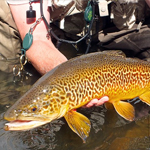 Tiger trout are a cross between a brown trout and a brook trout. These are extremely rare in nature. The fish is an irregularity in the wild, with the brook trout having 84 chromosomes and the brown trout 80.
Tiger trout are a cross between a brown trout and a brook trout. These are extremely rare in nature. The fish is an irregularity in the wild, with the brook trout having 84 chromosomes and the brown trout 80.
11. Triploid Trout
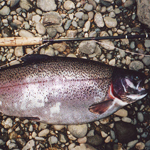 Triploid rainbow trout are named triploid because they possess three sets of chromosomes which render them sterile. The triploidy process involves the heating of eggs at 26 to 27 degrees C for 20 minutes at 20 minutes after fertilization.
Triploid rainbow trout are named triploid because they possess three sets of chromosomes which render them sterile. The triploidy process involves the heating of eggs at 26 to 27 degrees C for 20 minutes at 20 minutes after fertilization.
12. Apache trout
 The Apache trout, Oncorhynchus apache, is a species of freshwater fish in the salmon family of order Salmoniformes. It is one of the Pacific trouts. The Apache trout measures in length from 6 to 24 inches (61 cm), and weighs between 6 ounces and 6 pounds (2.7 kg). They are a yellowish-gold color with a golden belly and have medium-sized dark spots that are evenly spaced and that may extend below the lateral line and onto the dorsal and tail fins
The Apache trout, Oncorhynchus apache, is a species of freshwater fish in the salmon family of order Salmoniformes. It is one of the Pacific trouts. The Apache trout measures in length from 6 to 24 inches (61 cm), and weighs between 6 ounces and 6 pounds (2.7 kg). They are a yellowish-gold color with a golden belly and have medium-sized dark spots that are evenly spaced and that may extend below the lateral line and onto the dorsal and tail fins
13. Gila trout
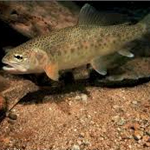 The Gila trout (Oncorhynchus gilae) is a species of salmonid, related to the rainbow, native to the Southwest United States. They have a yellow body, with black spots. The average total length is about 300.0 mm (11.8 in.); with maximum total length approximately 550.0 mm (21.7 in.). Gila trout can be found in small mountain water streams, and in confined pools.
The Gila trout (Oncorhynchus gilae) is a species of salmonid, related to the rainbow, native to the Southwest United States. They have a yellow body, with black spots. The average total length is about 300.0 mm (11.8 in.); with maximum total length approximately 550.0 mm (21.7 in.). Gila trout can be found in small mountain water streams, and in confined pools.
14. Donaldson Trout
The Donaldson trout was developed by the University of Washington thru selective breeding and nutrition, to attain a large body size in a short amount of time. Trout usually reach sexual maturity in about 4 years and weigh 1 1/2 pounds. The Donaldson, however, mature is two years and weigh up to 10 pounds, and they are prolific producing more eggs.
Health benefits of Rainbow trout
The rainbow trout (Oncorhynchus mykiss) is a type of trout and a species of salmonid originated in the cold-water waters of the Pacific Ocean in Asia and North America. The freshwater varieties have been introduced in the Great Lakes of North America. The American Heart Association recommends eating a 3-ounce serving of cooked fish at least twice a week. Rainbow trout is one of the healthiest fish you can include in your diet. One can maximize the health benefits of eating rainbow trout by cooking it from a variety of methods like steaming, grilling, broiling, or baking. Here are few of the health benefits of rainbow trout:
1. Excellent alternative for protein
If you are searching for a new food that increases your protein diet besides chicken, beef, and pork then Rainbow trout can be your new source of protein. A three-ounce serving of cooked rainbow trout consists 19 grams of protein. The Institute of Medicine recommends that you get between 10 to 35 percent of your total calories from protein. That means if your goal is to consume 1,800 calories per day, 180 to 630 of those calories should be from protein. According to the U.S. Food and Drug Administration, each gram of protein had 4 calories. Men should get about 56 grams of protein per day and women should consume about 46 grams of protein.
Protein consumption is vital for your body’s normal function. They are vital building blocks for muscles, skin, hair, nails, skin, blood, and cartilage. Most of the enzymes in your body that help you function properly are made of protein.
2. High in omega-3 fatty acids
Many “health gurus” tell people to stay away from fat. Anyway if you are trying to lose weight or gain weight, you need to consume fat. However, not all fats are created equal. You should stay away from some fats and gravitate to others. One of the fats you should gravitate to is the omega-3 fatty acids. The ratio between omega-6 fatty acids to omega-3 fatty acids is significant for healthy aging. It cannot be made in the body. Therefore, you must eat foods like rainbow trout that contain the rich nutrient.
A cooked serving of farmed rainbow trout consists of about 999 milligrams of omega-3 fatty acids eicosapentaenoic acid, or EPA, and docosahexaenoic acid, or DHA (found in fatty fish and algae). That far exceeds the 250-500 milligrams per day recommendation that the World Health Organization recommends. Also, that same serving contains only 245 milligrams of omega-6 fatty acids.
Rainbow trout can help balance out that omega-6 to omega-3 ratio. A balanced ratio can contribute to reducing the risk of heart attacks, heart disease, depression, anxiety, breast cancer, prostate cancer, and colon cancer.
3. Rich in potassium
Potassium is one of the most underrated minerals. Many people believe that if you simply decrease your salt intake, then your risk of high blood pressure would decrease. That is not true. Your body balances its salt by looking at its potassium to sodium ratio.
On a typical day, adults over the age of 19, teens between 14 to 18, and pregnant women should consume 4,700 milligrams of potassium each day and should consume no more than 2,300 milligrams of sodium each day, according to the Centers for Disease Control and Prevention. Rainbow trout contains 381 milligrams of potassium and 47.6 milligrams of sodium. That is an 8 to 1 ratio between potassium and sodium!
A potassium-rich diet not only helps manage high blood pressure, but provides relief from stroke, kidney disorders, anxiety, and stress. Potassium has also enhanced muscle strength, metabolism, and nerve function.
4. Good source of Phosphorus
Phosphorus is the second most abundant mineral in the body behind calcium. Phosphorus and calcium work together often to help maintain the integrity of bones and teeth, which is why 85 percent of the body’s phosphorus can be found in the bones and teeth. A phosphorus-rich diet plays other roles like facilitating an efficient digestive system by stimulating digestion with riboflavin and niacin and helping the proper release of waste while keeping the kidneys healthy. Also, phosphorus is the needed for the growth, maintenance, and repair of all tissues since they are needed for genetic building blocks, DNA and RNA.
Most people consume enough phosphorus in their diets. According to the Institute of Medicine, adults are recommended to consume 700 milligrams of phosphorus per day. Kids and teens between the age of nine and 18 are recommended to consume 1,250 milligrams of phosphorus per day. Rainbow yellow trout contains 226 milligrams of phosphorus each serving.
5. Excellent source of the B-vitamin complex
Thiamin, niacin, vitamin B6, vitamin B12, and pantothenic acid are categorized in the B-vitamin complex. Water-soluble vitamins play a major role in cell metabolism. Thiamin assists in the breakdown of sugars and amino acids to make them readily available for the body to use. Niacin helps the body break down carbohydrates, fats, and proteins into energy. Niacin also plays a role in removing harmful chemicals from the liver and makes various sex and stress-related hormones in the adrenal glands.
Vitamin B6 helps the body make several chemicals that help one brain cell communicate with another brain cell called neurotransmitters. The neurotransmitters in production are serotonin and norepinephrine, which can also influence your mood and the body’s internal clock.
6. Good source of the forgotten selenium
Not many people have heard of selenium, but selenium is an important trace mineral for normal brain function, a healthy immune system, and fertility for both men and women. Combined with vitamin E, selenium can act as an antioxidant and may reduce the risk of cancer and prevent sunburn. The most common place people may get their selenium intake is in mushrooms since selenium is found in soil but rainbow trout is a good source of selenium as well.
Children above the age of 13 and adults should consume 55 micrograms of selenium per day. Rainbow trout consists of 12.7 micrograms or 18 percent of the daily value of recommended selenium.
7. Low in contaminants
According to the Environmental Defense Fund, farmed rainbow trout is low in mercury and polychlorinated biphenyls or PCBs. Fish that contain high levels of mercury or PCBs may cause side effects like kidney damage, mental disorders, brain damage, and fatigue, especially in children and fetuses. Seafood Watch recommends avoiding wild-caught rainbow trout because of the increased risk of pollutants.
How to Eat
- Fresh rainbow trout can be baked whole or as fillets.
- Frozen rainbow trout can be cooked without being thawed if you can spare the additional cooking time.
- Rainbow trout are great to grill, fry, or broil. Rainbow trout is a great fish for people new to seafood, as it is quick and easy to prepare.
Other Facts
- Largest trout species is the lake trout, a native of the Great Lakes, Alaska and Canada that can weigh as much as 100 pounds.
- Rainbow trout are able to spawn at age 3 and usually only spawn every 3-5 years.
- Rainbow trout is considered endangered in some regions by the United States Federal Government because they are largely affected by stream damming, and sediment runoff.
- A group of rainbow trout is called a hover.
- If a rainbow trout migrates to the ocean in adulthood instead of staying in streams and rivers, it is called a steelhead. Their body is almost entirely silver.
- The biggest rainbow trout ever caught was in Canada in the year 2009 and weighed 48 pounds.
- The average lifespan for a rainbow trout is 4 to 6 years in the wild.
- Spawning season for rainbow trout occurs in the spring.
- Rainbow trout has been introduced to every continent except Antarctica.
- The color of rainbow trout meat will vary with diet and environmental conditions.
- Rainbow trout have been commercially farmed since 1870. The largest producer of farmed trout is Chile.
- A female trout can spawn from 200 to 8,000 eggs during season.
- Rainbow trout are indicators of water pollution because they can survive only in clean waters.
- They spawn in the streams where they were born.
- The fish has sharp teeth on the roof of its mouth but has no lower teeth at all.
Buying of Rainbow trout
Fresh or frozen rainbow trout have the same nutritional value. Your local grocery store or fish monger should have fresh rainbow trout available throughout the year. If you are buying fresh trout, select a whole or filleted fish that has shiny scales and is firm and somewhat elastic to touch. Fresh rainbow trout will have a mild odor but it shouldn’t smell fishy.
If buying frozen rainbow trout, avoid any fillets that show signs of brown discoloration or dried out edges. Select a package of frozen rainbow trout that has little or no air trapped inside to minimize freezer burn.
Storing
Wrap fresh rainbow trout in plastic wrap or store in an airtight container in the refrigerator for no longer than one or two days.
For longer storage, label the packaged rainbow trout with the date of purchase and freeze it for up to two months.
Preparing
Fresh rainbow trout can be baked whole or as fillets. Frozen rainbow trout can be cooked without being thawed if you can spare the additional cooking time. (Thawing frozen rainbow trout in cold water takes about 30 minutes per pound.)
To bake fresh rainbow trout, preheat the oven to 450°F (230°C). Rinse the fish and pat it dry with a paper towel. Place the whole or filleted trout in a baking pan, brush with olive oil and season to taste.
Estimate the thickness of the rainbow trout and bake for 10 minutes per one inch (2.5 cm) of thickness. Flip the trout half way through the cooking time, unless it’s less than half an inch (1 cm) thick.
If you’re cooking rainbow trout wrapped in foil or sauce, add five minutes to the cooking time.
Rainbow trout that’s opaque and flakes easily with a fork is ready to be enjoyed.
Rainbow trout Facts
Rainbow trout is a member of salmon family. There are 15 subspecies of rainbow trout that are native to western parts of North America. Rainbow trout can be found on all continents except on the Antarctica today. These fish inhabit cold streams and rivers, while some subspecies spend part of their life in the ocean. They live on a gravelly bottom with enough vegetation that provides shelter. Rainbow trout are popular game fish. They are also important food source for humans. Because of that, rainbow trout are often cultivated in aquacultures (commercial farms) throughout the world. Despite increased demand for rainbow trout, their number is still high and stable in the wild. These animals are not on the list of endangered species.
| Name |
Rainbow trout |
| Scientific Name |
Oncorhynchus mykiss |
| Common/English Name |
Trout, Rainbow Trout, Brown Trout, redband trout |
| Native |
Rivers and lakes of North America, west of the Rocky Mountains |
| Growing Climate |
They prefer cool, clear rivers, streams, and lakes, though some will leave their freshwater homes and follow a river out to the sea. |
| Back |
Range from brown, to olive, to dark blue |
| Belly |
Silver or pearly white |
| Fish Size & Shape |
Large, torpedo shaped fish about 20 to 30 inches (51 to 76 centimeters) long |
| Fish Color |
Generally blue-green or yellow-green in color with a pink streak along their sides, white underbelly, and small black spots on their back and fins. |
| Flesh Color |
White, pink, orange or dark red in color. |
| Fish Weight |
Around 8 pounds (3.6 kilograms) |
| Flavor |
Delicious, delicate, mild, nutty flavor |
| Predators |
Prey for larger fish, fish eating birds, including herons and kingfishers, eagles and mammals, including American Black bears, river otters, raccoons and humans. |
| Feed on |
Eats primarily invertebrate larvae, insects, crustaceans, fish eggs, minnows and small fish |
| Varieties |
- Brook Trout
- Steelhead Trout
- Brown Trout
- Cutthroat Trout
- Golden Trout
- Palomino Rainbow Trout
- Donaldson Trout
- Bull Trout
- Lake Trout
- Dolly Varden
- Tiger Trout
- Triploid Trout
- Apache trout
- Gila trout
|
| Lifespan |
4 to 6 years |
| Health benefits |
- Excellent alternative for protein
- High in omega-3 fatty acids
- Rich in potassium
- Good source of Phosphorus
- Excellent source of the B-vitamin complex
- Good source of the forgotten selenium
- Low in contaminants
|
| Major Nutrition |
Vitamin B-12 (Cobalamine) 2.92 µg (121.67%)
Vitamin D (Cholecalciferol) 13.5 µg (90.00%)
Isoleucine 0.815 g (48.74%)
Lysine 1.624 g (48.56%)
Tryptophan 0.198 g (45.00%)
Threonine 0.775 g (44.03%)
Valine 0.911 g (43.13%)
Histidine 0.52 g (42.21%)
Leucine 1.438 g (38.91%)
Selenium, Se 20 µg (36.36%)
Protein 16.9 g (33.80%)
Vitamin B3 (Niacin) 4.719 mg (29.49%)
Vitamin B5 (Pantothenic acid) 1.413 mg (28.26%)
Phosphorus, P 192 mg (27.43%)
Vitamin B6 (Pyridoxine) 0.274 mg (21.08%)
Total Fat (lipid) 5.24 g (14.97%)
Vitamin E (alpha-tocopherol) 1.98 mg (13.20%)
Vitamin A, RAE 71 µg (10.14%)
Choline 55.1 mg (10.02%) |
| Calories in 1 fillet (71 g) |
119 K cal |
References:
https://en.wikipedia.org/wiki/Rainbow_trout
http://www.dovemed.com/healthy-living/wellness-center/7-health-benefits-rainbow-trout/
https://lesliebeck.com/foods/rainbow-trout
http://www.chesapeakebay.net/fieldguide/critter/rainbow_trout
http://www.kidsafeseafood.org/rainbowtrout/
https://www.ontario.ca/page/rainbow-trout
http://jimruskfishingalaska.com/fishing-the-world-famous-kenai-river/trophy-salmon/rainbow-trout/
https://marinersmenu.org/2010/10/29/rainbow-trout/
http://www.nationalgeographic.com/animals/fish/r/rainbow-trout/
https://forum.americanexpedition.us/rainbow-trout-information-facts-photos-and-artwork#custom
http://www.softschools.com/facts/animals/rainbow_trout_facts/693/
http://online.sfsu.edu/bholzman/courses/Fall01%20projects/rainbow%20trout.htm
Comments
comments


